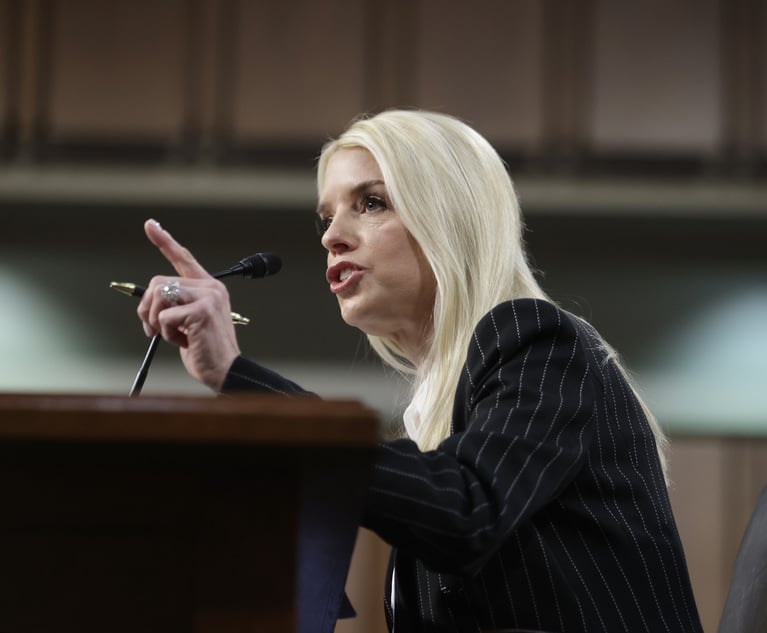How to Build an Intellectual Property Portfolio on a Budget
The ever-increasing speed at which information travels over social media and the expanding volume of information available on the internet has helped and hindered small and start-up enterprises.
April 30, 2019 at 11:38 AM
9 minute read
 Anthony S. Volpe of Volpe & Koenig.
Anthony S. Volpe of Volpe & Koenig.
The ever-increasing speed at which information travels over social media and the expanding volume of information available on the internet has helped and hindered small and start-up enterprises. It is easier to get recognition through social media but that recognition does not always translate into revenue. Likewise, it is easier to find information but the reliability of the information can be suspect. All of this matters because long-term business success is often the result of the access to funds for the next phase of research, marketing and expansion. The concern here is the strategy for financing that next phase, whether classic bank borrowing, bringing on investors or a private financing source as part of an exit strategy for cashing out.
Any effort to finance, whether through traditional banks, investor or private equity funds will ultimately turn on questions of what makes your business model unique and what protection do you have for that uniqueness. These questions will surface as part of the due diligence to determine market survivability and, in the event the business does not survive what security is there for the requested financing. The answer to what makes the business unique may be easy or self-evident. What protects the uniqueness of the business model may be more difficult to answer and its answer may depend to a large degree on the action taken years before the question was asked. The best answer may be the business entity's intellectual property portfolio (IP). An IP portfolio can have a varied combination of copyrights, trademarks, trade secrets, confidential information and patents. There is no set formula for what should be in an IP portfolio or the ratio of different IP rights in a respective portfolio.
Consider the example of a business producing a food product that uses a proprietary blend of known spices to achieve a unique flavor. That particular blend of spices may be protected by confidentiality and noncompete agreements with employees, the supplier and the various state and federal trade secret laws. While these agreements can be a good source of protection that are reusable, they must be carefully drafted to cover all that needs to be covered without becoming overly broad or restrictive of employee movement to become subject or to be stricken as such. For the budget-constrained entity, these can be a one-time investment in form agreements that need not be so extensive to be budget busting. So this is a good, relatively inexpensive start of an IP portfolio. As a word of caution, such forms should be reviewed periodically to ensure continued compliance with the current laws. Assuming these agreements are a basis for protecting the uniqueness of the product, how does one go about meeting demand and expanding the production to multiple sites?
Expansion to multiple sites is likely to mean that product procedures or recipes will need to be written in some medium that is accessible to different individuals. Although the individual employees may be covered under agreements, there is still a need to protect the information whether it is stored on paper or in an electronic form. Protection for this component of the IP portfolio is available under the copyright laws. Instruction manuals are protectable by copyright and the copyright laws have provisions for filing information as a trade secret. Copyright registration is another good, relatively inexpensive component of an IP portfolio and the Library of Congress has some very helpful circulars for those who want to venture forth and file their own applications. Information stored on a computer can be copyright protected and may be easier to limit access through permissions, passwords and random time-limited tokens like RSA Securid. In addition to copyright protection, commercial information stored on a computer that has limited access to authorized personnel may have an additional enforcement mechanism in the federal computer fraud statutes.
Registered copyrights have a long life term and are assignable as a property right. Accordingly, properly secured and registered rights can provide a long-term business asset that is fully transferable for value, separately or as part of the business entity.
A second grouping of relatively inexpensive but value IP rights is found in the trademark laws. Trademarks come in a territorial version, common law; a limited geographic area of protection, intrastate or state trademark laws; and, national protection, interstate or federal trademark laws. As might be expected, the requirements and cost associated with them vary according to the protection desired. Common law rights do not require registration and are acquired through use of the mark. State trademarks are acquired by registration based upon use within the state. Federal rights are acquired by registration based on interstate use of the mark. Thus, federal registration requires the use of the mark in commerce across state lines so as to qualify as interstate commerce. A federally register trademark has nationwide coverage and is particularly effect for expansion, whether organically or through franchising. In the case of a franchise, the trademark combines nicely with the confidential information, trade secrets and operation manuals reference above to create the basic information transferred to a franchisee. And, the trademark provides an identifier for the business that traveling consumer can recognize and depend upon as a measure of product or service quality.
All federal trademark rights are acquired through an application and examination process that takes place in the trademark branch of the U.S. Patent and Trademark Office (USPTO). The state trademark registrations process is less expensive than the federal trademark application and examination process, but both are relatively inexpensive means of acquiring a potentially valuable business asset.
Although a startup or small business may not initially consider trademarks to be important, it should consider the current value of trademarks like McDonald's, Coke, Exxon or Marriott. Each of these companies was once a startup or small business that is now recognized as a dominate entity in its market segment. These marks also demonstrate the variety of businesses that can benefit from developing a robust trademark portfolio.
Basic information regarding the federal registration process for a trademark can be found at https://www.uspto.gov/trademarks-getting-started/trademark-basics.
Another important category of IP rights is found in the patent laws that provide for certain exclusive rights in inventions. All patents are federal rights that are acquired through an application and examination process that takes place in the various patent examination groups in the USPTO. The patent examination groups are organized according to the technology or subject matter of the patent application. The examining groups are further classified according to whether the application is for a utility or design patent. Utility patents, as the name implies, cover the utility of an invention or the way it works. For example, an improvement in how a transmission works would be a utility patent. Design patents cover the appearance of an object so long as the appearance is not dictated by the object's function. For example, a perfume bottle can be the subject of a design patent because the perfume does not dictate the bottle's appearance. Design patents are often used in conjunction with trademarks as a means of identifying a source of a product. Although a design patent cannot replace or duplicate a trademark, the years of use can create a long-term image of a product source, such as the distinctive Coke bottle.
Patent protection is available for almost any that is new and useful. This standard is very broad and the usefulness of the invention is judged liberally and does not get into matters of practicality or cost. There are some limits to what can be patented. For example, patents are not available for things that are laws of nature, such as gravity, but a patent can be granted for things that use a law of nature to achieve a result different from pure gravity.
The cost associated with patents can vary greatly. Design patents are relatively inexpensive and provide a more limited exclusivity. Utility patents are typically higher than of the cost of design patents but provide a broader scope of protection. The decision on which form of protection should be pursued is also generally more involved and expensive. For either form, it is often best to have a prior art search conducted on the subject invention. This search can provide a snapshot of the prior art an examiner might apply against the proposed patent application, and it might uncover an existing patent that may potentially be infringed by the subject invention.
Patents, like the other IP rights, can be licensed or sold and are often value components of an IP portfolio.
Basic information regarding the patent application process can be found at https://www.uspto.gov/patents-getting-started/general-information-concerning-patents.
To summarize the intellectual property portfolio-building process, it is critical to have a plan from the outset. Start with the form of the business organization and a form nondisclosure and noncompete agreement that covers employees and suppliers. Then focus on things like manuals and recipes that can be copyrighted and any potential trademarks. Finally, look at the operations of the business and decide if there are any patentable inventions. It may not be possible to do everything, but that does not excuse doing nothing. The early choices may be dictated by the available funds, but the small things may be what are needed to have the necessary funds for bigger things in the future. Remember, McDonald's, like many other fast food establishments, sells hamburgers!
Anthony S. Volpe is a shareholder at Volpe and Koenig. He has corporate and private practice experience in all aspects of intellectual property rights.
This content has been archived. It is available through our partners, LexisNexis® and Bloomberg Law.
To view this content, please continue to their sites.
Not a Lexis Subscriber?
Subscribe Now
Not a Bloomberg Law Subscriber?
Subscribe Now
NOT FOR REPRINT
© 2025 ALM Global, LLC, All Rights Reserved. Request academic re-use from www.copyright.com. All other uses, submit a request to [email protected]. For more information visit Asset & Logo Licensing.
You Might Like
View All
Lawyers' Phones Are Ringing: What Should Employers Do If ICE Raids Their Business?
6 minute read


3rd Circuit Strikes Down NLRB’s Monetary Remedies for Fired Starbucks Workers
Trending Stories
Who Got The Work
J. Brugh Lower of Gibbons has entered an appearance for industrial equipment supplier Devco Corporation in a pending trademark infringement lawsuit. The suit, accusing the defendant of selling knock-off Graco products, was filed Dec. 18 in New Jersey District Court by Rivkin Radler on behalf of Graco Inc. and Graco Minnesota. The case, assigned to U.S. District Judge Zahid N. Quraishi, is 3:24-cv-11294, Graco Inc. et al v. Devco Corporation.
Who Got The Work
Rebecca Maller-Stein and Kent A. Yalowitz of Arnold & Porter Kaye Scholer have entered their appearances for Hanaco Venture Capital and its executives, Lior Prosor and David Frankel, in a pending securities lawsuit. The action, filed on Dec. 24 in New York Southern District Court by Zell, Aron & Co. on behalf of Goldeneye Advisors, accuses the defendants of negligently and fraudulently managing the plaintiff's $1 million investment. The case, assigned to U.S. District Judge Vernon S. Broderick, is 1:24-cv-09918, Goldeneye Advisors, LLC v. Hanaco Venture Capital, Ltd. et al.
Who Got The Work
Attorneys from A&O Shearman has stepped in as defense counsel for Toronto-Dominion Bank and other defendants in a pending securities class action. The suit, filed Dec. 11 in New York Southern District Court by Bleichmar Fonti & Auld, accuses the defendants of concealing the bank's 'pervasive' deficiencies in regards to its compliance with the Bank Secrecy Act and the quality of its anti-money laundering controls. The case, assigned to U.S. District Judge Arun Subramanian, is 1:24-cv-09445, Gonzalez v. The Toronto-Dominion Bank et al.
Who Got The Work
Crown Castle International, a Pennsylvania company providing shared communications infrastructure, has turned to Luke D. Wolf of Gordon Rees Scully Mansukhani to fend off a pending breach-of-contract lawsuit. The court action, filed Nov. 25 in Michigan Eastern District Court by Hooper Hathaway PC on behalf of The Town Residences LLC, accuses Crown Castle of failing to transfer approximately $30,000 in utility payments from T-Mobile in breach of a roof-top lease and assignment agreement. The case, assigned to U.S. District Judge Susan K. Declercq, is 2:24-cv-13131, The Town Residences LLC v. T-Mobile US, Inc. et al.
Who Got The Work
Wilfred P. Coronato and Daniel M. Schwartz of McCarter & English have stepped in as defense counsel to Electrolux Home Products Inc. in a pending product liability lawsuit. The court action, filed Nov. 26 in New York Eastern District Court by Poulos Lopiccolo PC and Nagel Rice LLP on behalf of David Stern, alleges that the defendant's refrigerators’ drawers and shelving repeatedly break and fall apart within months after purchase. The case, assigned to U.S. District Judge Joan M. Azrack, is 2:24-cv-08204, Stern v. Electrolux Home Products, Inc.
Featured Firms
Law Offices of Gary Martin Hays & Associates, P.C.
(470) 294-1674
Law Offices of Mark E. Salomone
(857) 444-6468
Smith & Hassler
(713) 739-1250





